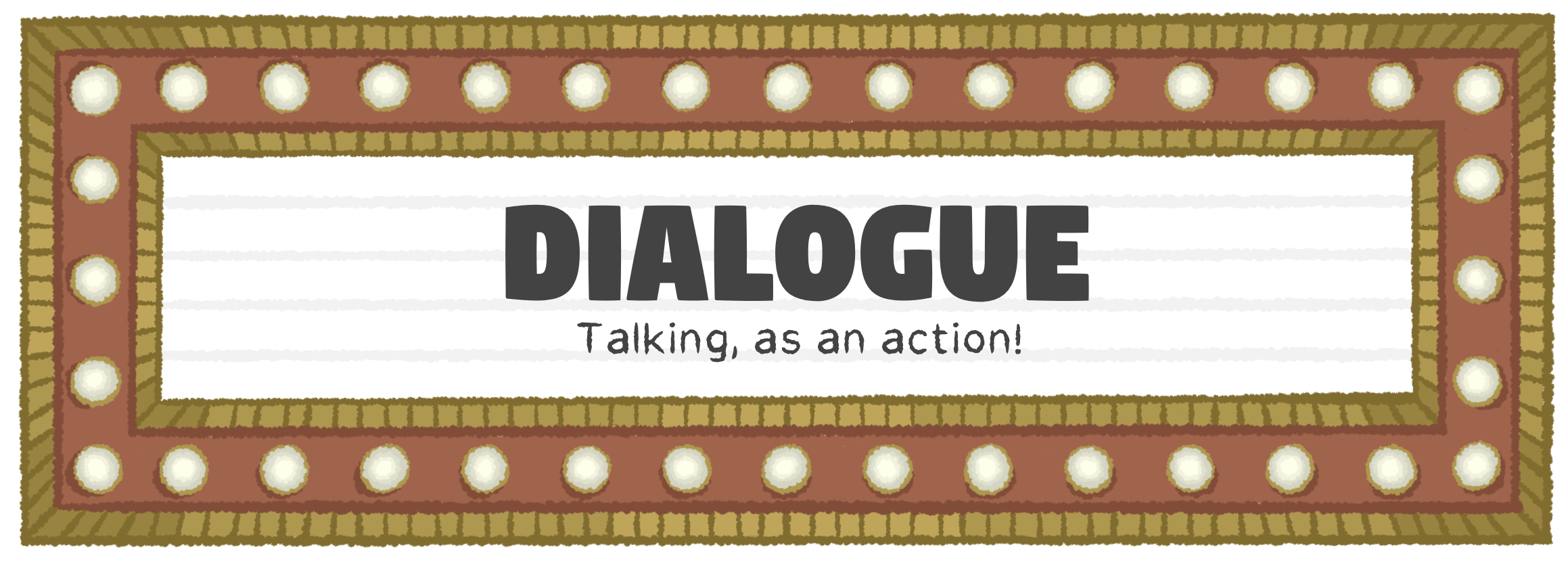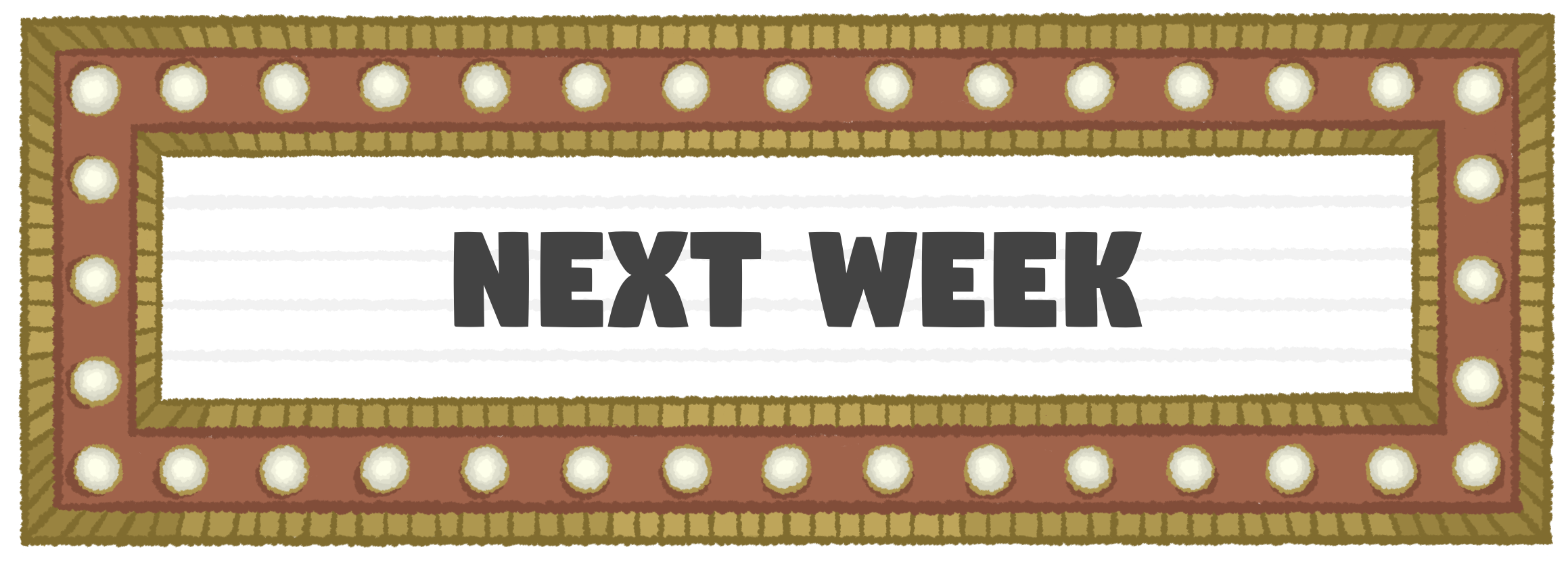

| My Tutorial |
|---|
| How to tell a story through conversation |
|
When a character speaks,
The main thing that I've learned after researching this lesson about dialogue, is that dialogue is really really hard to teach. In large part because when you're writing dialogue, you are role-playing as a character. And everybody's process for getting into character is going to be a little bit different. So even though I'm a very architectural writer, it breaks my heart to tell you I don't have like one unified theory for how to approach dialogue. So this lecture may be a little messy, a little all over the place. Because I do have some solid architectural, structural ways that I approach dialogue! They help me figure out which character should say what next. But at the end of the day, if you're going to write scripts, you're going to have to figure out your own process for this. Because when you're writing a novel, you're telling it from the perspective of the narrator. There is also dialogue in a novel, but really you're focused on sounding like whoever the narrator is. And that's how you're telling the story. But when you're writing a script, you're mostly telling the story through dialogue. Usually dialogue is not explicitly addressing the audience. The characters aren't narrating to the audience. But the conversation that they're having just-so-happens to narrate where they are, at that particular moment in their life. So dialogue is a combination between a conversation & telling a story. It's a conversation that demonstrates the story. It's a conversation about the story. It's a conversation that results from the story. So when I'm writing my script & I'm figuring out what to say next, I can always return to the story. |
|
3 Main Types of Dialogue
Usually when I'm writing dialogue, I'm writing out a scene. So usually I'm writing for the conflict of the scene. But depending on which scene it is, I might also be writing for the conflict of the story overall, or the dialogue might be about the conflict of the major action that's happening in this scene. Or I might be writing dialogue that gives the audience a bit of a break from the conflict of the scene. But ultimately, every line of dialogue is about the conflict. "Someone wants something badly, but they have trouble getting it." As a result, there are three main types of dialogue, three main uses for dialogue. Exposition, characterization, and action. With expository dialogue, the character says something in a way that includes the audience into the conversation. It catches the audience up to speed. Maybe it introduces them to the setting, or gives them a detail that's going to be important later in the story, or tells us what the relationship is between this character and the character who they're talking to. Expository dialogue lets the audience play along. So expository dialogue, and characterization is the next one. Characterization is dialogue where the character behaves in a way that only they could. They demonstrate how they're unique and distinct from the other characters in the story. The obvious approach to characterization is to have the characters choose different types of words. Maybe they have different slang. Maybe they are members of different classes; one character had more education than another. Maybe they have different ideologies... like maybe it's a chauvinist & a feminist. Those characters pick different subjects to talk about, different subjects to joke about, different subjects to argue about. So that's going to color the way that they approach the conversation. But the bigger challenge with characterization is how the characters problem-solve. Which brings us to the third category. We've done exposition, we've done characterization, and now here's action. Dialogue as an action. As a unit of plot. Using dialogue to try to achieve the objective, or overcome the antagonism. Because scripts are mostly conversations, a lot of your dialogue will in fact also double as an action in the plot. Because remember, each conversation in your script is based around the conflict. So these are conversations with a purpose. These characters are up against a problem. Each character has an objective, each character has antagonism, and they're talking it out. So how do they solve the problem that they're facing? If you are up against this conflict, what could you say to get yourself out of it? And that's where the big challenge of characterization comes in! Do you know your characters well enough, to know the different ways that they approach problem solving? Or does every character solve a problem, exactly like you solve a problem? I wish I had more insights for you about how different people solve different problems, but this is just a thing you kind of need to go out into the world and observe for yourself. Pay attention to your loved ones, pay attention to your social circle. When they're faced with a real life conflict, how do they approach it? How do they try and overcome their antagonism? How do they try to achieve their objective? And if you were in their shoes, what would you do? It's a sketchy exercise, but it can help you wrap your head around how to do this. When I first heard about this exercise, I was in a writer's group at the Winter Park Library. And the writer who explained it said, "Oh yeah, you can do really terrible things to the people you care about, in fiction." Isn't that horrible?? These people didn't do anything wrong! Their only crime was knowing a writer!! So to recap, whenever you're writing dialogue, the three main things you're trying to do are include the audience with exposition, demonstrate the character with characterization, or perform an action that moves the story forward. A line of dialogue can do just one of these things, or two, or even all three at the same time! But those are the goals. |
|
Dialogue can go deep
It's also interesting when you're talking about dialogue to consider how deep you want the text to go! Remember, the text of the story is the conflict & the plot. "Someone wants something badly, but they have trouble getting it... so here's what happens." That's the text of the story. The subtext of the story is the arc & the theme. The protagonist's internal conflict, the self-sabotaging behavior that they're struggling to get out of. And the theme, which is how the storyteller feels about the protagonist's decisions. Are they making good choices? Are they making bad choices? Why? Usually when people talk, when people have conversations, they are not talking about what's going on inside their minds. They're not talking about their feelings. They're not talking about what the storytelling god puppeteer thinks they should and shouldn't do. Usually they're talking about the text. They're talking about their everyday life. So a good creative challenge is to figure out how to shape the text, how to pick the right actions, the right settings, the right circumstances, the right conflicts that symbolize what's going on inside the character, that demonstrate the character's internal life, the stuff that they're struggling with. That way the character can start by talking about the text, which is what most people do, but eventually more and more of the subtext slips into what they're talking about. That's a classic way to approach it. |
|
Example 1: a scene from
|
|
Example 2: a scene from
|
|
Example 3: a scene from
|

| Creative Challenge |
|---|
| Write a dialogue scene! |
|
🎦 Write a script, for a scene that's mostly dialogue! And if you want a bonus challenge? Type it out, like a screenplay! A typical scene is 3-5 pages long, and follows a common script format. |
Do you want help getting started? Here are some prompts! Feel free to use them, change them, or ignore them altogether. Pick some of your favorite characters from the story you're working on. Write a script for them that centers around...
|

| Pitching |
|---|
| Zoom out & summarize your story |
|
🎦 () |